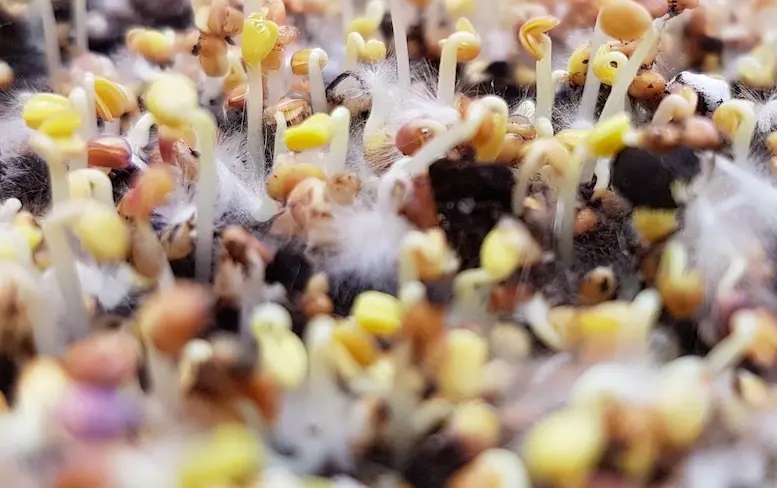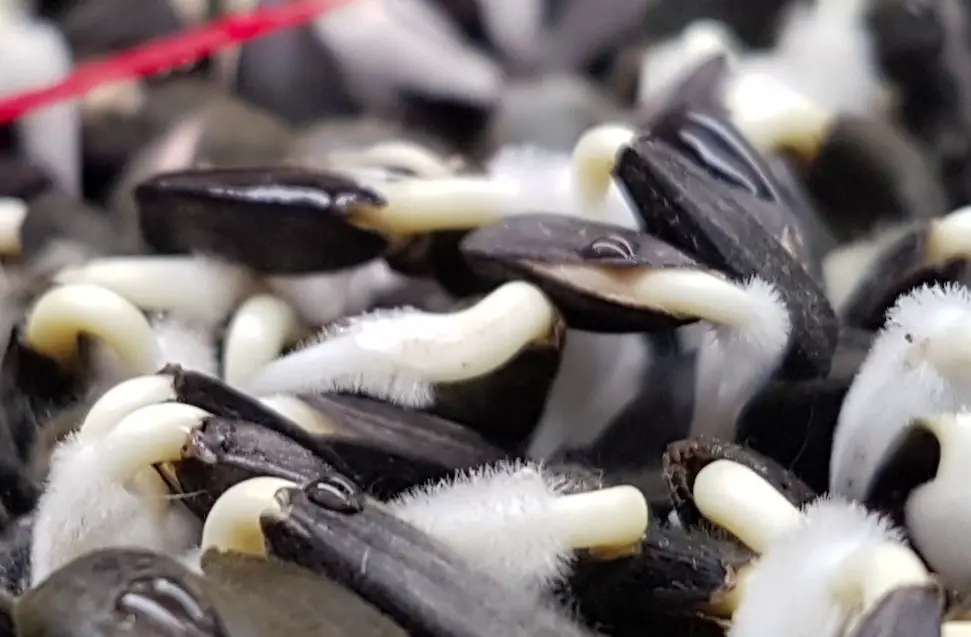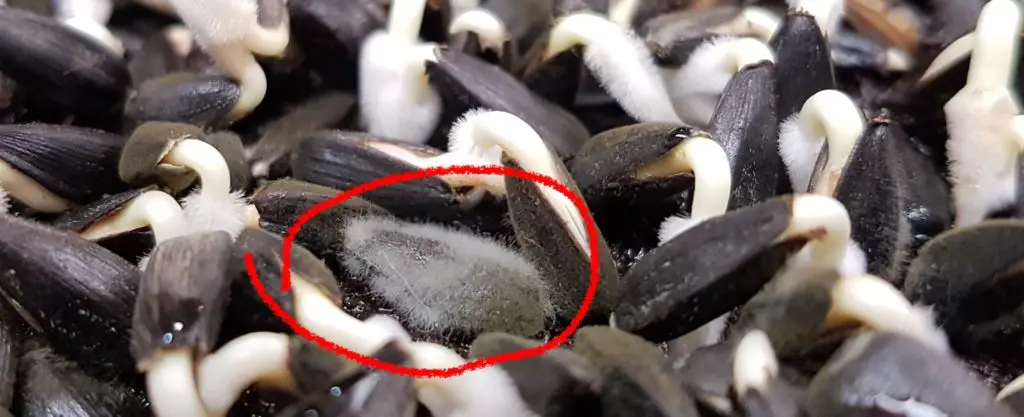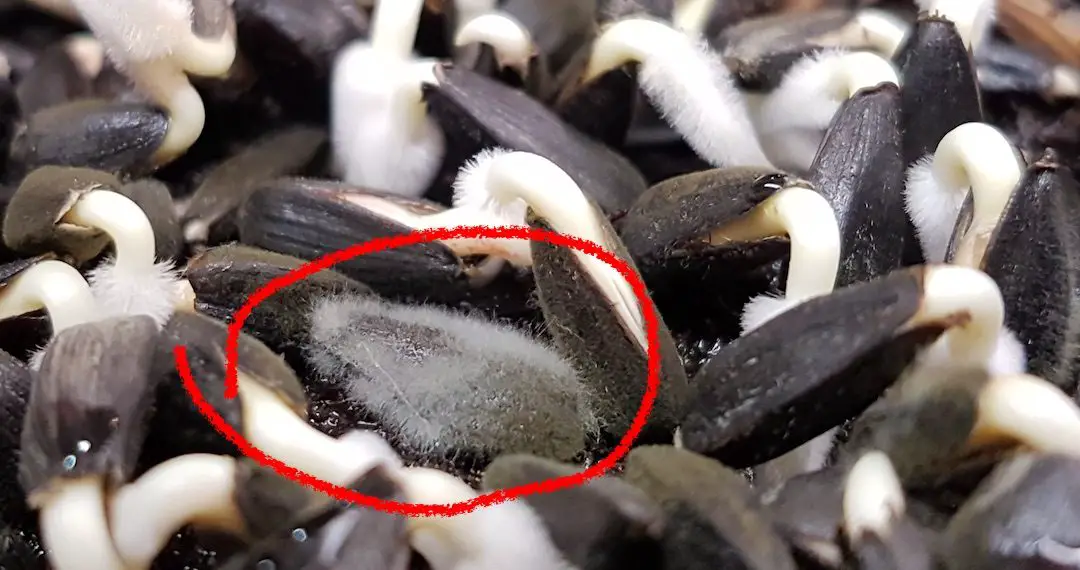Ideally you prevent it in the first place. But if you have mold, you can remove it with a few methods. If you’re growing a small amount of microgreens, you can remove moldy bits, like shed seed hulls.
You can spray with a hydrogen peroxide, peracetic acid, or dilute bleach solution. Whichever method you use, make sure there are no harmful residues remaining by the time you harvest, and that the plants aren’t damaged.
Make sure you’re dealing with mold.
Sunflower, radish, and many other microgreens have fine white roots that look like mold. Sanitize seeds, tools, equipment and soil. Make sure temperatures are between 20C and 25C, humidity isn’t too high, and the soil is draining well.
Microgreens shouldn’t smell sour, fishy, or musty. You can cut moldy parts out of your tray if it’s isolated. Soak your seeds for 10 minutes in a mixture of 1 oz of 5% vinegar, 3 ounces (90 mL) of 3% hydrogen peroxide, and a pint (500mL) of water. Rinse well at least twice then plant. Use the same mixture to spray microgreens after a blackout period.
Why do my microgreens smell bad?
If your microgreens have a smell that’s fishy, or musty, or otherwise pungent, you might have a problem. Inspect your seeds and soil for signs of fungus or other microbial growth. It’s normal for seeds to have a faint smell after germination, but it shouldn’t be sour or particularly unpleasant. I like the smell that they’re supposed to have, for what it’s worth.
A bad smell is probably coming from microorganisms that have taken over. They’re out-competing everything else, and producing spores and aromatics that you can smell.
If you really can’t see anything wrong, keep growing them and see if the smell goes away. Monitor for signs of mold growth. Look for anything fuzzy or differently colored than the soil. Mold will often be most visible on un-germinated seeds, or seed hulls that have been shed.

The above photo shows moldy pea microgreens. This tray had a bad smell. It was the first pea microgreen tray I grew and I made a couple mistakes that I think led to mold growth. I didn’t sterilize the seeds, and I watered from the top instead of the bottom (between the trays).
It’s also possible you’re just not used to the smell of the seeds. If the microgreens have a bad smell when mature (1-3”), toss them, it’s not worth the risk. I wish it was easier to describe smells, or share them by e-mail! Good luck.
Microgreens mold or roots?
Microgreen roots from some species look like white mold. But, you can tell the difference with a little practice and a little help from some photos.

Pictured above is healthy arugula microgreens that germinated a day earlier. The fuzzy white stuff is normal root growth. They’re really fine hairs, and if you look closely you can see the hairs are all coming from living plants. Nothing to worry about here.
Microgreen mold can form, but
In a closed system with high humidity and containment, pathogens can take off quickly.
Mold on sunflower microgreens
If you think your sunflower greens are going moldy, first make sure it’s mold!
Sunflower and a lot of other microgreens have little white roots initially that look a lot like mold. The roots look like this:

Pictured above are healthy sunflower microgreens that started germination 2 days earlier. The white fuzzy cones are normal fine root growth. There’s nothing to worry about here! Things look healthy.
Fuzzy bits that are any color other than white are probably mold. Or if they’re white, but look like spiderwebs, or aren’t attached to a growing microgreen: it’s mold. The roots will always be coming out of a microgreen sprout or stem. If there’s fuzz on a sunflower seed, or a seed hull, it’s mold.
The white fuzz at the base of sunflowers is normal. Radish does it, pea shoots don’t.
Circled in red below is a photo of a sunflower seed that failed to germinate, and is showing grey mold growth:

How do I tell if my microgreens have a disease?
For some plants, disease seems virtually unavoidable. It’s almost impossible to maintain a perfect growing environment, perfect supplies, and perfect seeds. But, there’s a lot you can do to keep it under wraps.
It’s still normal to have a little bit pop up here and there, especially if you’re taking a more organic approach, and not sterilizing your seeds and growing medium.
And even if you are, mold spores in the air, and a nice humid moist microgreen tray are a match made in heaven (or hell?).
Look for mold on the soil surface and the vegetation. If you see it growing, spot treat it with a dilute mixture of hydrogen peroxide or another sanitizer. You want to make sure you use something that won’t leave harmful residues on the plants.
Certain conditions favour pathogen growth. Moisture. Have you over-watered your trays and soil is saturated? You should be able to squeeze your soil lightly and not have water come out.
If your soil porosity (the space between the soil grains) is completely full of water, your microgreen roots aren’t getting any air. If there’s no air you have anaerobic soil conditions. Anaerobic conditions promote mold, and some other pathogens.
Ventilation keeps the air moving, and reduces the humidity near the soil surface. More fans are better than less. Improving airflow can be an easy fix.
Planting density is another factor in airflow.
Hot, humid climates are more at risk. Can reduce planting density to get better airflow if humidity and temperature are elevated.
Sewing or seeding density
If you’re growing in an environment where you can’t control the temperature closely you’ll have to make some changes to seeding density. As temperatures get hotter decrease sewing density. Hotter temperatures tend to favor microbial growth, so having less density gives you better ventilation.
A new source of seed or new variety can introduce seed density problems, potentially leading to mold growth. If you were getting away without sterilizing seeds in your old batch, your new batch might not be as pristine. If your seeds are obviously larger or smaller, you can increase or decrease your seeding density to get the same amount of plants.
Be careful not to get water on the floor. Any water on the floor, or trapped under trays evaporates int the air, increasing humidity. Puddles can also host mold and other microorganisms. Use a dehumidifier to reduce humidity if you’re having issues.
Planting density depends on:
- Species/cultivar: for example sunflower seeds will have much fewer seeds than arugula
- Seed size: smaller seeds usually result in smaller microgreens, so can be planted denser
- Every batch of seed might be different, one might be 330mL, another might be 400mL
- Want maximum seed on tray without overcrowding
- Do most tray at your current best-guess density, do a few higher and a few lower to test.
- Different systems: hydroponic vs soil
Low seed germination increases mold
If your seed doesn’t germinate at high rates, the un-germinated seeds will tend to mold and decompose. If you’re buying seed, try a smaller bag before ordering large quantities, see how it grows. Ask if it’s possible to order from the same lot for your larger order.
When buying seeds, consider the following:
- Germination rate: above 95% is ideal.
- Seed size: are all the seeds uniformly sized? Is there a lot of variation?
- Debris in with seed (ex: bird seed is high in debris)
- Source (local, reputable, shipping, there are many tradeoffs)
- Leaf size: are many leaves stunted or odd shaped?
- How well it sheds its hull, this is also an indicator of vigor.
- Make sure variety is correct (ex: red radish that’s not red)
- Vigor: how quickly and healthily the microgreens grow
- Uniformity: are all the seeds germinating and growing similarly?
- Texture: do the seeds all look similar?
- How old is the seed (harvest date, not packaging date)
Storing seeds improperly can exposed them to high or low temperatures. This can damage the seed and cause it to grow poorly or not at all. Extended storage, even in good conditions can cause degradation, this is why it’s important to consider when the seed was harvested, if that information is available to you.
There are a lot of techniques you can use to improve germination, if the seeds are in good condition. Seeds need warmth, water, and soil to germinate. Soaking seeds increases germination. Soil needs moisture to keep seed hydrated. Growing conditions need to be right, check those first.
Washing harvested microgreens
Washing greens is a double-edged sword. Try to avoid washing greens if you can. Washing greens can bruise them, and damage the natural cuticle (protective coating) on the vegetation.
Just like our skin, plants have natural barriers to decomposers. If those barriers are damaged by mechanical handling, or chemicals, the plant has weakened defences.
When you’re watering, avoid kicking up dirt. If the spray is fine and gentle enough it won’t kick up dirt. If you’re using a double tray (one perforated, one solid) you can bottom water. Add water to between the trays and let the soil imbibe it through capillary forces.
Greens that aren’t washed keep longer, as long as they’re healthy and don’t have soil or pathogens growing on them.
If you’re growing your microgreens in a greenhouse, or outdoors, harvest at the right time of day when it’s cool. Warm-harvested microgreens are less crisp, and don’t seem to keep as well. If you have to harvest when they’re warm, cool them down as soon as you can.
If you’re going to apply a sanitizing agent directly to your greens, consult your local government for what’s allowable. The USDA requirements are available here.
Drying greens after washing is critical in keeping them fresh for as long as possible. Wet greens don’t keep well.
Is wheatgrass mold dangerous?
It depends what type of mold it is, and how much of it there is. We ingest mold and mold spores every day, from the air, and from food we eat. It’s the amount, and the type of mold that matters.
There’s an active debate online on whether or not wheatgrass mold is dangerous, I don’t think there’s too much to think about. You shouldn’t eat mold if you can avoid it. Some fungi and yeasts are fine to eat, but generally not if it’s growing on other food.
In a microgreen setting, there’s no reason you have to put up with wheatgrass mold. Disinfect seeds with a 10minute hydrogen peroxide soak before you plant them as you normally would.
If your sprouted wheatgrass plants have mold growing on the vegetation, discard that section of plants, especially any color of mold other than blue. You can do a spray of your seeds after you uncover them after germination.
If you have any adverse reaction to consuming wheatgrass greens or juice. Stop eating or drinking it.
Blue or blue/green mold often grows on the seeds after their sprout. If it spreads to the vegetative part of the microgreens, discard them. If it stays on the seeds, you should be alright. For more info on microgreen mold, check out this great article from Wheatgrass Greenhouse.
Conclusion
- Make sure you’re dealing with mold. Sunflower, radish, and many other microgreens have fine white roots that look like mold. Err on the side of caution if you’re not sure.
- Microgreens shouldn’t smell sour, fishy, or musty.
- Soak your seeds for 10 minutes in a mixture of 1 oz of 5% vinegar, 3 ounces (90 mL) of 3% hydrogen peroxide, and a pint (500mL) of water. Rinse well at least twice then plant.
- Use the same mixture to spray microgreens after a blackout period.
- If you’re having consistent mold problems, focus on sanitizing tools and equipment.
- Don’t re-use soil, unless you’ve composted it fully, and are sure pathogens aren’t are at minimal levels. Make sure soil drains well, and isn’t waterlogged.
- Make sure temperatures are between 20C and 25C, too high and microorganism growth is favored, too low and water won’t evaporate as quickly. More standing water is more real estate for mold growth.
- Keep humidity down. Water carefully, don’t spill water on the floor, and clean it up if you do. Use a humidifier if necessary.
Sources
Chandra, D., J.G. Kim, and Y.P. Kim. 2012. Changes in microbial population and quality of microgreens treated with different sanitizers and packaging films. Hortic Environ Biotechnol. 53:32-40.
USDA Allowed Detergents and Sanitizers for Food Contact Surfaces and Equipment in Organic Operations
Wheatgrass Greenhouse FAQ (discussion on wheatgrass mold 1/2 way down)

I’m Alex Lafreniere. I learned a lot about plants when I built and operated a landscaping company. But, there’s always more to learn. Ever since travelling across the world, I’ve wanted to find ways to bring more tropical and exotic plants into my life. This is the site where I share everything I’ve learned with you.
This site is owned and operated by Plant Hardware, a sole proprietor headquartered in Calgary, Canada. Plant Hardware is a participant in the Amazon Services LLC Associates Program, an affiliate advertising program designed to provide a means for sites to earn advertising fees by advertising and linking to Amazon.com.Plant Hardware may also participate in affiliate programs with Bluehost, Clickbank, CJ, ShareASale, and other sites. Plant Hardware is compensated for referring traffic and business to these companies.

